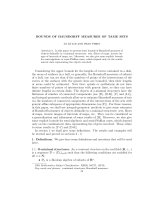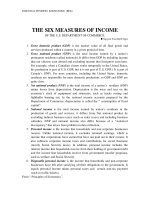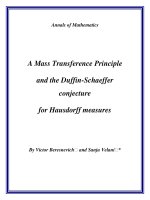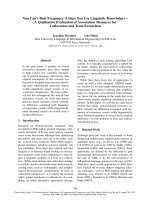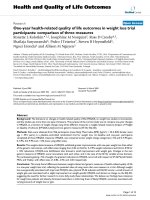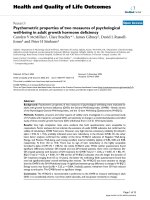Bounds of Hausdorff Measures V2(3-2009)
Bạn đang xem bản rút gọn của tài liệu. Xem và tải ngay bản đầy đủ của tài liệu tại đây (176.68 KB, 11 trang )
BOUNDS OF HAUSDORFF MEASURES OF TAME SETS
TA L
ˆ
E LOI AND PHAN PHIEN
Abstract. In this paper we present some bounds of Hausdorff measures of
objects definable in o-minimal structures: sets, fibers of maps, inverse im-
ages of intervals of maps, etc. Moreover, we also give some explicit bounds
for semi-algebraic or semi-Pfaffian cases, which depend only on the combi-
natoric data representing the objects involved.
Considering the upper bounds for the lengths of curves contained in a disk,
the areas of surfaces in a ball, or generally, the Hausdorff measures of subsets
of a ball, one can see that if the numbers of points of the intersections of the
curves or the surfaces with the generic lines are bounded, then their lengths
or areas could be estimated. Note that, spirals or oscillations do not have
finite numbers of points of intersections with generic lines, so they can have
infinite lengths in certain disks. The objects of o-minimal structures have the
finiteness of number of connected components (see [D], [D-M], [C] and [L1]),
and integral-geometric methods allow us to estimate Hausdorff measures of sets
via the numbers of connected components of the intersections of the sets with
generic affine subspaces of appropriate dimensions (see [F]). For these reasons,
in this paper, we shall use integral-geometric methods to give some estimates
of Hausdorff measures of objects definable in o-minimal structures: sets, fibers
of maps, inverse images of intervals of maps, etc. They can be considered as
a generalization and refinement of some results of [H]. Moreover, we also give
some explicit bounds for semi-algebraic and semi-Pfaffian cases, which depend
only on the combinatoric data representing the objects involved. These relate
to some results in [Y-C] and [D-K].
In section 1 we shall give some definitions. The results and examples will
be started and proved in sections 2 - 5.
1. Definitions. We give here some definitions and notations that will be used
later.
1.1. O-minimal structures. An o-minimal structure on the real field (R, +,·)
is a sequence D = (D
n
)
n∈N
such that the following conditions are satisfied for
all n ∈ N:
• D
n
is a Boolean algebra of subsets of R
n
.
1991 Mathematics Subject Classification. 32B20, 58C27, 14P10.
Key words and phrases. o-minimal structures, Hausdorff measures.
39
40 TA L
ˆ
E LOI AND PHAN PHIEN
• If A ∈ D
n
, then A × R and R× A ∈ D
n+1
.
• If A ∈ D
n+1
, then π(A) ∈ D
n
, where π : R
n+1
→ R
n
is the projection
on the first n coordinates.
• D
n
contains {x ∈ R
n
: P (x) = 0}, for every polynomial P ∈ R[X
1
, . . . , X
n
].
• Each set in D
1
is a finite union of intervals and points.
A set belonging to D is said to be definable (in that structure). Definable
maps in structure D are maps whose graphs are definable sets in D.
The class of semi-algebraic sets and the class of sub-Pfaffian sets ([K] and
[W]) are examples of such structures, and there are many interesting classes of
sets which have been proved to be o-minimal. For important properties of o-
minimal structures we refer the readers to [D], [D-M], [C], [L1] and [W]. Note
that by Cell Decomposition [D] Ch.3 Th.2.11, the dimension of a definable set
A is defined by
dim A = max{dim C : C is a C
1
submanifold contained in A}
In this note we fix an o-minimal structure on (R, +,·). “Definable” means
definable in this structure.
1.2. Diagrams of semi-algebraic sets. Let A ⊂ R
m
be a semi-algebraic set
represented by A = ∪
p
i=1
∩
j
i
j=1
A
ij
, where each A
ij
has the form:
{x ∈ R
m
: p
ij
(x) 0},
where p
ij
is a polynomial of degree d
ij
and ∈ {>,≥}.
The set of data D = D(A) = (m, p, j
1
, . . . , j
p
, (d
ij
)
i=1,...,p; j=1,...,j
i
) is called the
diagram of the set A.
1.3. Formats of Semi-Pfaffian sets.
Pfaffian chains. A Pfaffian chain of length r ≥ 0 and degree α ≥ 1 in an
open domain U ⊆ R
m
is a sequence of analytic functions f = (f
1
, . . . , f
l
) in U
satisfying a system of Pfaffian equations
∂ f
i
∂ x
j
(x) = P
ij
(x, f
1
(x), . . . , f
i
(x)), ∀x ∈ U (1 ≤ i ≤ l, 1 ≤ j ≤ n).
where P
ij
are polynomials of degree not exceeding α.
Pfaffian functions. We say that q is a Pfaffian function of degree β with the
Pfaffian chain f if there exists a polynomial Q of degree not exceeding β such
that
q(x) = Q(x, f
1
(x), . . . , f
l
(x)), ∀x ∈ U.
QF formulae. Let P = {p
1
, . . . , p
s
} be a set of Pfaffian functions. A
quantifier-free formula (QF formula) with atoms in P is constructed as fol-
lows:
• An atom is of the form p
i
0, where 1 ≤ i ≤ s and ∈ {=,≤,≥}. It
is a QF formula;
BOUNDS OF HAUSDORFF MEASURES OF TAME SETS 41
• If Φ and Ψ are QF formulae, then their conjunction Φ ∧ Ψ, their dis-
junction Φ ∨ Ψ, and the negation ¬Φ are QF formulae.
Semi-Pfaffian sets. A set A ⊆ U is called semi-Pfaffian if there exists a
finite set P of Pfaffian functions and a QF formula Φ with atoms in P such
that
A = {x ∈ U : Φ(x)}.
Formats of semi-Pfaffian sets. Let A be a semi-Pfaffian set as above. Then
the format of A is the set of data F = F (A) = (m, l, α, β, s), where m is the
number of variables, l is the length of f, α is the maximum of the degrees
of the polynomials P
ij
, β is the maximum of the degrees of the functions in
P,and s is the number of the functions in P.
1.4. A formula of integral geometric measure. Let m be a positive
integer. For each k ∈ {0, . . . , m}, let H
k
(A) denote the k-dimensional Haus-
dorff measure of A ⊂ R
m
. Let O
∗
(m, k) denote the space of all orthogonal
projections of R
m
onto R
k
, i.e.
O
∗
(m, k) = {p| p : R
m
→ R
n
linear and p ◦ p
∗
= id
R
k
}
The orthogonal group O(m) acts transitively on O
∗
(m, k) through right mul-
tiplication. This action induces a unique invariant measure θ
∗
m,k
over O
∗
(m, k)
with θ
∗
m,k
[O
∗
(m, k)] = 1.
The Cauchy-Crofton formula. By [F] 2.10.15 and 3.2.26, for every Borel
subset B of R
m
, we have
H
k
(B) = c(m, k)
O
∗
(m,k)
R
k
#(B ∩ p
−1
(y))dydθ
∗
m,k
p
where c(m, k) =
Γ(
m+1
2
)Γ(
1
2
)
Γ(
k+1
2
)Γ(
m−k+1
2
)
, and Γ(s) =
+∞
0
e
−t
t
s−1
dt (s > 0).
2. Uniform bounds of the Betti numbers of the fibers.
Proposition 1. Let f : A → R
n
be a continuous definable map. Let i ∈ N.
Then there exists a positive number M
i
, such that the i-th Betti numbers of the
fibers of f are bounded by M
i
B
i
(f
−1
(y)) ≤ M
i
, for all y ∈ R
n
.
In particular, the numbers of connected components of the fibers of f are uni-
formly bounded.
Moreover, if f is semi-algebraic (reps. semi-Pfaffian), then M
i
only depends
on the diagram (resp. the format) of f.
42 TA L
ˆ
E LOI AND PHAN PHIEN
Proof. By Hardt’s Trivialization Theorem [D] Ch.9 Th.1.2, there is a finite
partition f(A) = C
1
∪ . . . ∪ C
M
of A into definable sets C
i
such that f is
definable trivial over each C
i
. Hence the family of the fibers of f has only
finitely many embedded definable topological types. So the Betti numbers
are uniformly bounded. Moreover, when f is semi-algebraic or semi-Pfaffian,
by [B],[G-V] or [K],[Z],[G-V-Z], the Betti numbers are bounded by constants
depending only on the diagram or the format of f.
3. Hausdorff measures of definable sets. Let A be a subset of R
m
. For
each k ∈ {0, . . . , m}, define
B
0,m−k
(A) = sup{B
0
(A ∩ p
−1
(y)) : p ∈ O
∗
(m, k), y ∈ R
k
}
Note that if A is definable, then, applying Proposition 1 to the canonical
projection
{(x, p, y) ∈ A × O
∗
(m, k) × R
k
: p(x) = y} → {(p, y) ∈ O
∗
(m, k) × R
k
}
we get the boundedness of B
0,m−k
(A). Moreover, if A is semi-algebraic or
semi-Pfaffian, then B
0,m−k
(A) is bounded by an explicit constant depending
only on the diagram or the format of A (see the examples below).
Theorem 1. Let A, B be definable subsets of R
m
. Suppose B is compact,
dim A = k, and A ⊂ B. Then
H
k
(A) ≤ c(m, k)B
0,m−k
(A) sup
p∈O
∗
(m,k)
H
k
(p(B))
If moreover A, B are semi-algebraic or semi-Pfaffian sets, then
H
k
(A) ≤ C sup
p∈O
∗
(m,k)
H
k
(p(B))
where C is a constant depending only on the diagram or the format of A.
Proof. By [D] Ch.4. Prop.1.5, for each p ∈ O
∗
(m, k), dim(B ∩ p
−1
(w)) ≤ 0,
and dim(A ∩ p
−1
(w)) ≤ 0, for all w ∈ R
k
outside a definable set of dimension
less than k. By the Cauchy-Crofton formula, we get the estimate
H
k
(A) = c(m, k)
O
∗
(m,k)
R
k
#(A ∩ p
−1
(w))dwdθ
∗
m,k
p
≤ c(m, k)B
0,m−k
(A)
O
∗
(m,k)
R
k
1
p(A)
dwdθ
∗
m,k
p
≤ c(m, k)B
0,m−k
(A)
O
∗
(m,k)
R
k
1
p(B)
dwdθ
∗
m,k
p
≤ c(m, k)B
0,m−k
(A) sup
p∈O
∗
(m,k)
H
k
(p(B))
The last assertion is followed by Proposition 1.
BOUNDS OF HAUSDORFF MEASURES OF TAME SETS 43
Corollary 1 (c.f. [Y-C] and [D-K]). Let A be a definable subset of R
m
of
dimension k. Then for any ball B
m
r
of radius r in R
m
,
H
k
(A ∩ B
m
r
) ≤ c(m, k)B
0,m−k
(A)Vol
k
(B
k
1
)r
k
.
Proof. From the preceding theorem, we get
H
k
(A ∩ B
m
r
) ≤ c(m, k)B
0,m−k
(A)H
k
(B
k
r
) = c(m, k)B
0,m−k
(A)Vol
k
(B
k
1
)r
k
Example 1.
Algebraic case. When A ⊂ R˜
m
is a k-dimensional algebraic set of degree d,
then
H
k
(A ∩ B
m
r
) ≤ c(m, k)dVol
k
(B
k
1
)r
k
.
In particular, when A is an algebraic curve of degree d in the plane, then the
length l(A ∩ B
2
r
) ≤ c(2, 1)d2r = πdr.
Semi-algebraic case. Generally, when A ⊂ R
m
is a k-dimensional semi-
algebraic set of diagram D = (m, p, j
1
, . . . , j
p
, (d
ij
)
i=1,...,p;j=1,...,j
i
), then
H
k
(A ∩ B
m
r
) ≤ c(m, k)B
0
(D)Vol
k
(B
k
1
)r
k
where B
0
(D) =
1
2
p
i=1
d
i
(d
i
− 1)
m−1
, with d
i
=
j
i
j=1
d
ij
. (see [Y-C], [B])
Semi-Pfaffian case. We say that U is a domain of bounded complexity γ for
the Pfaffian chain f = (f
1
, . . . , f
l
) if there exists a function g of degree γ in
the chain f such that the sets {g ≥ ε} form an exhausting family of compact
subsets of U for ε 1. We call g an exhausting function for U.
Let A be a k-dimensional semi-Pfaffian set defined by a fixed Pfaffian chain
f = (f
1
, . . . , f
l
) of degree α in a domain U ⊆ R
m
with format (m, l, α, β, s),
where U is a domain of bounded complexity γ for f. Using [Z] Remark.1.30,
Th.2.25, Remark 2.26, and applying Corollary 1, we get
H
k
(A ∩ B
m
r
) ≤ c(m, k)(4s + 1)
d
V(m, l, α, β
∗
, γ)Vol
k
(B
k
1
)r
k
where
V(m, l, α, β
∗
, γ) = 2
l(l−1)
2
β
∗
(α + β
∗
− 1)
n−1
γ
2
[n(α + β
∗
− 1) + γ + min(m, l)α]
l
with β
∗
= max(β, γ).
4. Uniform bounds of Hausdorff measures of definable fibers. Let
f : A → R
n
be a definable map, where A ⊂ R
m
. For each k ∈ {0, . . . , dim A},
let
I
k
(f) = {y ∈ R
n
: dim f
−1
(y) ≤ k}
Then, by [D] Ch.4.1.6, I
k
(f) is definable. Let
B
0,m−k
(f) = sup{B
0
(f
−1
(y) ∩ p
−1
(w) ∩ B
m
(a, r)) : y ∈ I
k
(f), p ∈ O
∗
(m, k),
w ∈ R
k
, a ∈ R
m
, r > 0}
